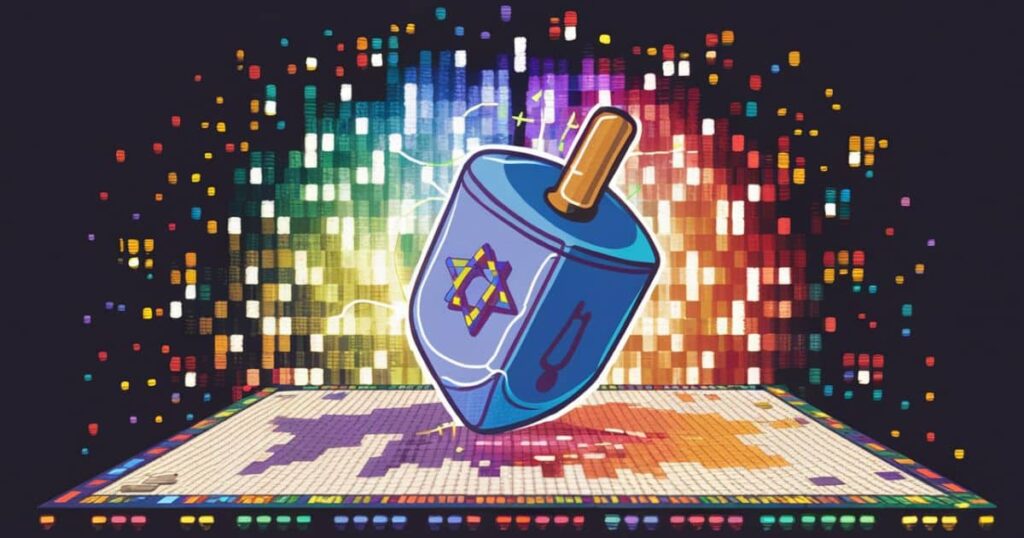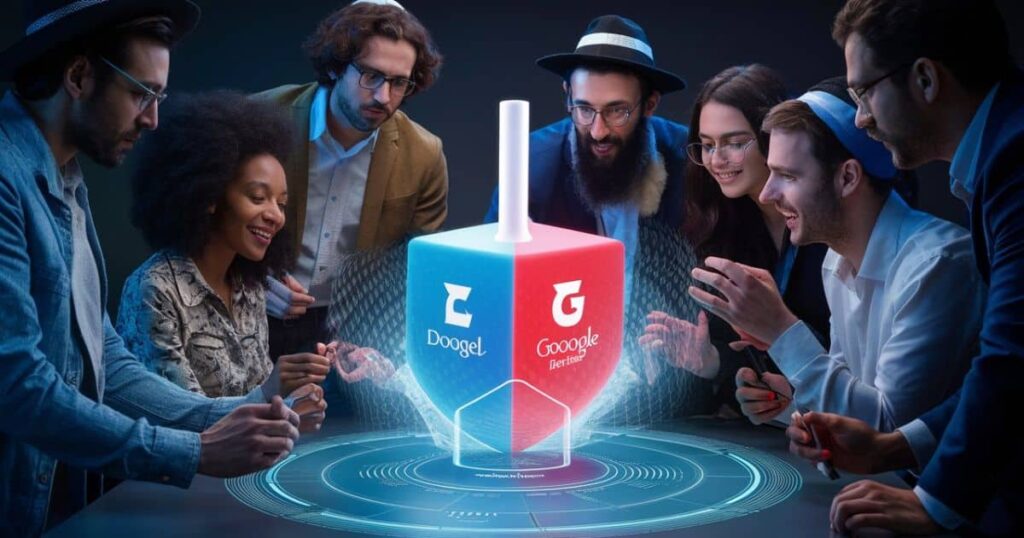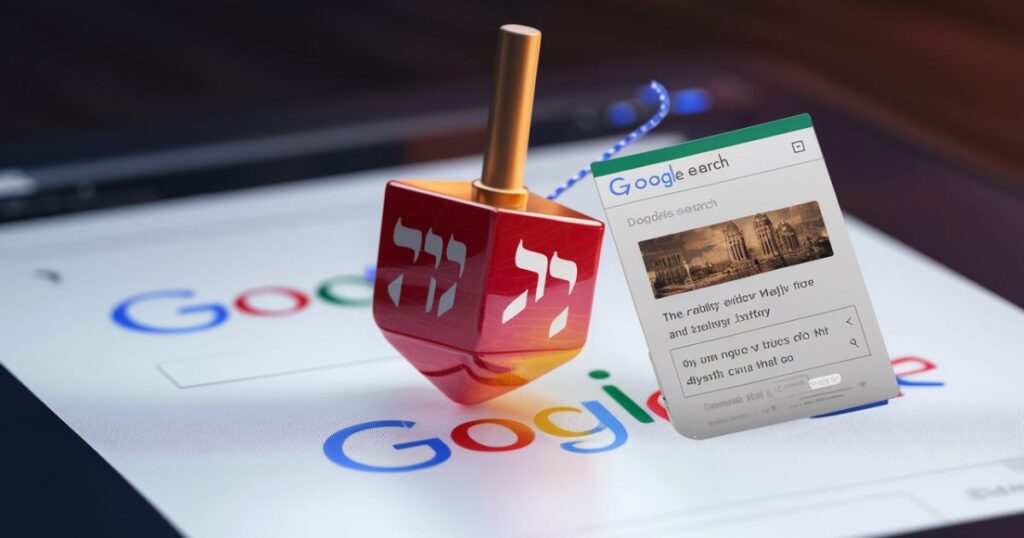As a child, the rhythmic whir of a dreidel spinning on the table was the sound of Hanukkah in my home. The simple four-sided top, adorned with Hebrew letters, held deep symbolism and brought my family together for an age-old game steeped in Jewish tradition. While the dreidel may seem like a modest token, it embodies the importance of preserving cultural legacies for generations to come. And in our digital age, Google’s interactive dreidel doodle has delightfully spun this tradition into the 21st century, introducing its rich meaning to global audiences.
The Timeless Tradition of the Dreidel
The dreidel game traces its roots back to the ancient Greeks and Romans, who played with spinning tops as a form of entertainment. However, it took on special significance for Jews during the Greek-Syrian persecution, when studying the Torah was outlawed. To conceal their learning, Jews would quickly stash away their sacred texts and pretend to be gambling with a spinning top if caught by officials.
Over time, the four Hebrew letters adorning the dreidel’s sides – נ (nun), ג (gimel), ה (hei), ש (shin) – came to symbolize the phrase “נס גדול היה שם” (Nes Gadol Hayah Sham), which translates to “A great miracle happened there”, referring to the miracle of the Maccabees’ victory and the oil that burned for eight nights.
The traditional way to play involves each player putting a token (often coins or nuts) into the center pile, taking turns spinning the dreidel, and either adding or removing tokens from the pile based on which letter lands face-up:
- Nun = “Nothing” (do nothing)
- Gimel = “Get” (take the whole pile)
- Hei = “Half” (take half the pile)
- Shin = “Share” (put one token in)
As players spin and the pile dwindles or grows, the game is accompanied by singing traditional Hanukkah songs like “I Have a Little Dreidel” or “Sevivon Sov Sov Sov” (The Dreidel Spins). For many Jewish families, playing dreidel encapsulates the festive joy of Hanukkah while passing down an ancient custom tied to resilience and cultural preservation.
Google’s Doodle Delights – Digitizing the Dreidel

On December 16th, 2020, Google’s homepage featured an interactive dreidel doodle to celebrate the first night of Hanukkah. With a click, users could set the digital dreidel spinning and play the classic game against an online opponent.
“We felt it was a fun way to make learning about and experiencing the dreidel game accessible to everybody.” – <!– –>Google Doodler Zach Lieberman
The doodle meticulously recreated the unique physics and probability mechanics of the real-life dreidel spin. It also incorporated whimsical visual details like animating the Hebrew letters and projecting shadows to mimic candlelight. Furthermore, educational prompts taught users the meaning behind each letter and the traditions associated with the game.
According to Google’s data, the dreidel doodle garnered over 16 million plays worldwide during its run on the homepage. This global engagement sparked curiosity about Hanukkah and Jewish culture among diverse audiences who may have been unfamiliar with the tradition.
Transcending Boundaries, One Spin at a Time
While the dreidel game originated as a means of covertly preserving Jewish identity, Google’s doodle ironically brought it into the spotlight for all to learn about and experience. Imagine someone across the world who had never heard of Hanukkah suddenly discovering this unique tradition simply by visiting Google’s homepage.
In that moment, the digital dreidel transcended geographic and cultural boundaries, inspiring interest and dialogue about the history and customs behind the game. And as users delved deeper, spinning the dreidel became a gateway into understanding the broader context of Jewish faith, values, and resilience forged through persecution and hardship.
This cross-cultural exchange epitomizes how sharing traditions through innovative, interactive mediums can foster unity and mutual understanding in our globally interconnected world. As writer Marilynne Robinson eloquently stated, “Culture has no quality unless it acknowledges cultural diversity; any other stance is an explicit acknowledgment of the ultimately unimportance of the particular culture.”
Read This Post: Is Boost Mobile Down? A Comprehensive Look At Recent Outages
Technological Trendsetters in Cultural Preservation

Google’s dreidel doodle is just one example of how tech companies increasingly leverage their creative platforms to celebrate heritage and promote cultural literacy. Here are a few other notable examples:
- Facebook’s Augmented Reality Diwali Spark Filter (2022) – An AR selfie experience with animated lamps and firecrackers to mark the Indian festival of lights.
- Apple’s Fertility Celebrating Emojis (2021) – New inclusive emojis of images related to pregnancy, birth, and postpartum support were added.
- Snapchat’s Day of the Dead Lenses (2020) – Immersive AR lenses allowed users to adorn themselves with traditional calaca skull makeup.
From doodles and filters to special emoji additions, these digital tributes demonstrate how iconic cultural symbols and artforms can be reimagined for contemporary mediums. By meeting audiences on the innovative tech platforms they frequent, these rich traditions are more likely to be learned, appreciated, and upheld by younger generations.
As Harvard scholar Diana Muir states, “When we ignore the artistic aspects of cultures in the name of progress and globalization…we risk losing part of the very kernel that has allowed human diversity to persist.”
| Preservation Methods | Description |
| Digital Archiving | Scanning/digitizing physical cultural artifacts for online records |
| Interactive Exhibits | Museum displays utilizing VR/AR/apps to engage audiences |
| Content Partnerships | Collaborations with content creators to spotlight traditions |
| Online Curricula | Educational courses teaching cultural heritage and skills |
Looking ahead, Google could expand its celebration of Jewish customs by featuring interactive doodles or AR experiences around traditions like:
- Making hamantaschen cookies for Purim
- Crafting a sukkah hut for the Sukkot harvest festival
- Learning Hebrew calligraphy for writing Torah scrolls
The possibilities are vast for leveraging technology as a bridges between the past and future.
Final Thoughts
Just as the dreidel’s spinning motion has captivated children for centuries, Google’s dreidel doodle has spun the traditions of Hanukkah into the digital age with whimsical delight. Beyond just being an entertaining pastime, this interactive experience has illuminated the deeper cultural meanings and values enshrined within the game’s simple design.
So take a moment this Hanukkah to click the digital dreidel into motion. As the familiar letters dance across your screen, remember the timeless tale of resilience that each revolution represents – a powerful ode to preserving one’s cherished identity and traditions against all odds. And perhaps, the next spin will kindle your curiosity to learn about the rich tapestry of cultures that coexist with our own in this beautifully diverse world.







